Most tourists are naturally drawn not to Krakow Kazimierz at first, but to the beautiful Main Market Square with its magnificent Cloth Halls and St. Mary’s Church. The Wawel, the old castle of the Polish kings, also attracts masses of curious visitors. But the third “highlight” of Krakow is without a doubt the quaint Jewish quarter in Krakow – Kazimierz, which is located south of the Old Town. In this article we would like to introduce you to this formerly independent Jewish city. If you are interested in Krakow in general, just click here. And here you can find our practical travel tips for a trip to Krakow.
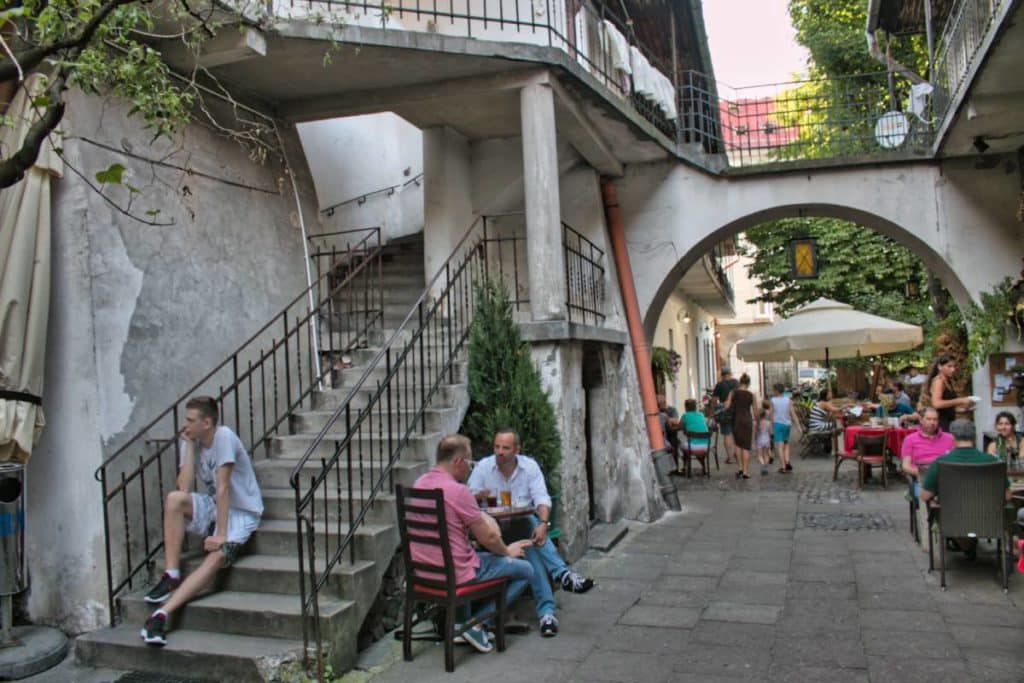
This is Kazimierz, the Jewish quarter in Krakow
Today Kazimierz is a small district of Krakow, which adjoins the historic center to the southeast and is framed to the south by the Vistula, the country’s most important river. Here, numerous historic buildings have survived the turmoil of time, so that today the district looks like an open-air museum. After the Nazis destroyed the centuries-old Jewish heritage in most places in the territories they occupied, it seems almost miraculous that so many traces of the Jewish past have survived here and that we can admire some of the most significant sites of the rich Jewish history in Eastern Europe here today.
History of Kazimierz
According to some sources, Jews were already living in the city of Krakow in the 11th century. At the end of the 11th century, several pogroms took place in Prague against the Jewish population, who subsequently left the city. Many moved to the Kingdom of Poland, which had a comparatively tolerant policy towards the Jews.
There are few written records of Jewish life in the city from that time, but it is certain that in the 14th century several Jewish families lived in the so-called Judenstraße (Ulica Żydowska) in the Vicus Judeorum (Jewish Quarter) outside the city walls and on the northeastern edge of Krakow. It is also said that at that time there were already three synagogues.
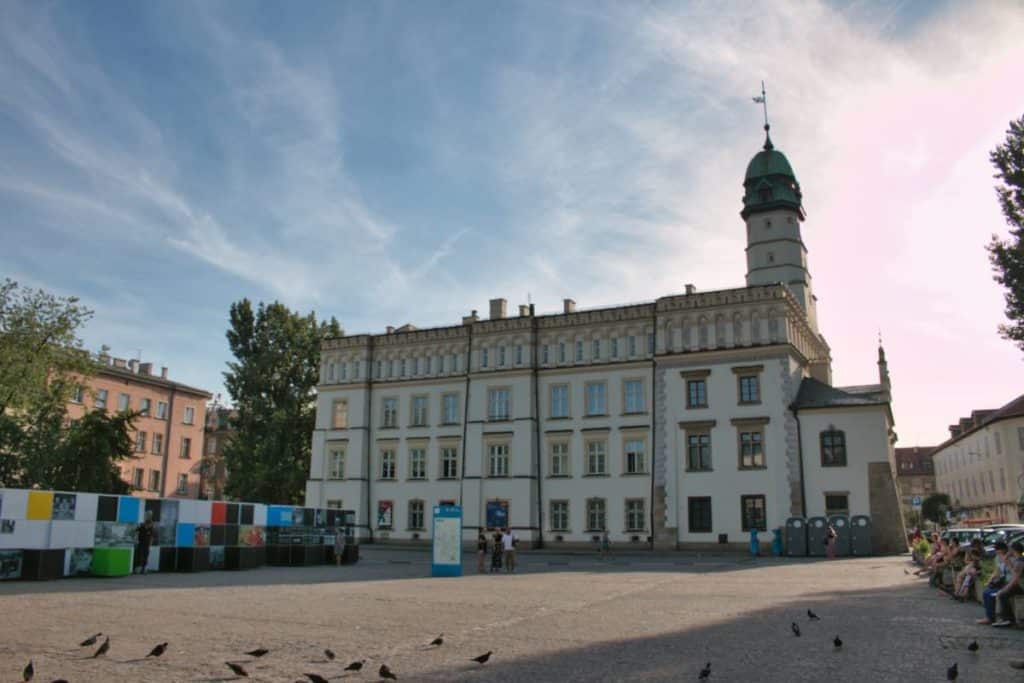
The emergence of Kazimierz
In 1494 there was a great fire in the city, which also destroyed many buildings inhabited or otherwise used by Jews. The fire hit especially the Jewish houses very hard. However, since some houses inhabited by Christians were also affected, the Jews were summarily blamed for the fire. This led to more and more Jews settling beyond the city walls in what is now Kazimierz. They were joined by more and more Jews from what is now the Czech Republic and Germany.
Many came to Krakow specifically to listen to the words of the famous Jewish scholars Jakob Pollak and Moses Isserles, who were two of the most influential figures of that time. Kazimierz also flourished for this reason during the Renaissance and pre-modern times. For example, the first Hebrew-language book in Poland was printed here in 1521.
Turbulent times
By the middle of the 17th century, around 4,000 people were already living in Kazimierz, an impressive number for that time. The following decades were associated with great difficulties for the Jews in Kazimierz, epidemics, a city fire and the so-called Swedish Flood hindered further growth of the neighborhood.
In the meantime, Jews were temporarily allowed to settle in Krakow again. Therefore, a significant Jewish community developed there as well, especially in the Kleparz district. However, when a trade ban was imposed on them in the middle of the 18th century, many of them moved to Kazimierz, which was still administered independently. This development intensified when in 1761 a mob destroyed over 50 stores in Krakow.
Under Austrian rule
In the course of the Polish Partitions, Krakow and Kazimierz came under Austrian control. From 1801 onwards, Jews were forbidden to settle outside Kazimierz, which had been incorporated a year earlier. The following decades were associated with changing political affiliations for Krakow. In the middle of the 19th century, several Jewish denominations emerged in Krakow, which also entered into architectural competition. Some of the most beautiful synagogues in Poland were built during that period.
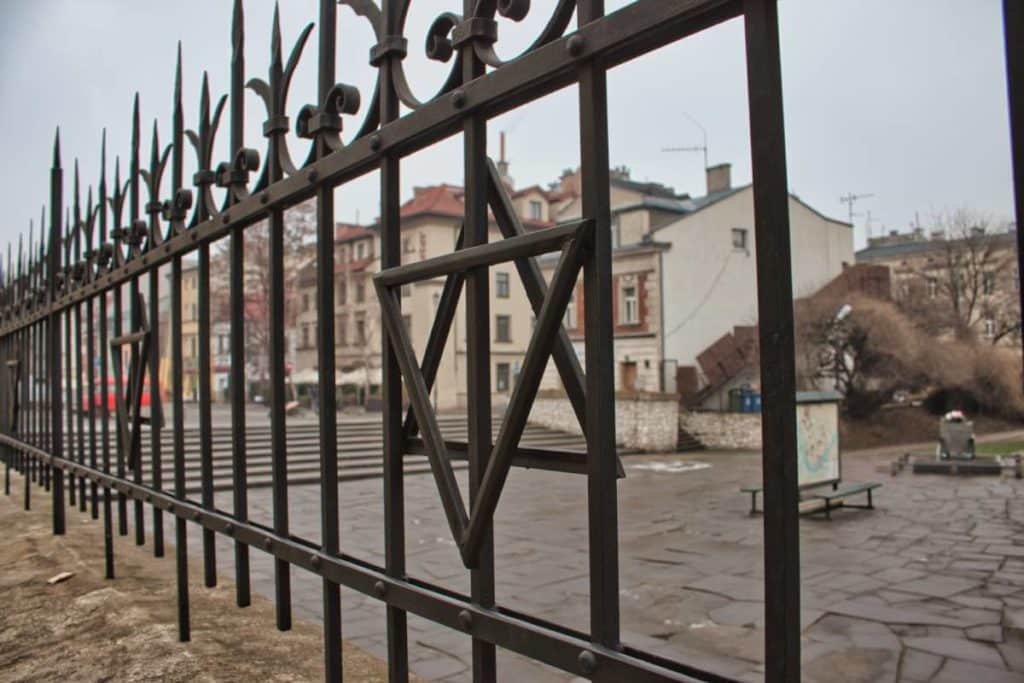
Kazimierz grows and grows
Within 50 years, the population of Kazimierz doubled to 30,000, and Jews were now again allowed to settle in other parts of the city. More and more Jews from Russia and the Russian-administered part of Poland moved to Krakow at the beginning of the 20th century, because they could practice their faith more freely here and attacks on the Jewish population were much less frequent. This trend continued during the short period of Polish independence, which did not bring an economic upswing for Kazimierz, but a cultural flourishing that never returned.
The begin of the German occupation
At the outbreak of World War II, the number of Jews in Krakow was estimated at about 60,000, or about a quarter of the total population. At that time, there were about 130 synagogues and prayer houses in the city. World War II and the German occupation had devastating consequences for Krakow’s Jews as well. Krakow was the capital of the newly created General Government of Poland, headed by Hans Frank, who administered the governorate from the Wawel Castle.
Podgorze and Plaszow – Places of horror
Immediately after the beginning of the German occupation, the Nazis began to systematically exclude and disenfranchise the Jews. A separate ghetto was established in Podgorze, a district that until then had been inhabited by more wealthy Jews. The goal was to make Kraków a “Jew-free” city. Due to the flight of many Jews from other parts of the from the German territories, the number of people in Kazimierz and Podgorze continued to grow.
At the end of 1942, it was decided to establish a labor camp in the Plaszow district on the other side of the Vistula. At that time, the SS had already taken over the “final solution of the Jewish question” from the German civil administration, which made the situation of Kraków’s Jews even worse. Plaszow was run by Amon Göth, the cruel SS-Untersturmführer whom many of you may remember from the movie “Schindler’s List,” when he shoots indiscriminately at ghetto residents with his rifle in the morning for “early morning exercise.” Particularly cruel was also the fact that the camp was partially built over two Jewish cemeteries, whose graves were thus desecrated.

Deportation and murder
Then, in March 1943, the Kraków ghetto was dissolved and its still living inhabitants were deported to Belzec, Auschwitz and Palszow. Many of them were then further transferred to the Lublin district, where they were murdered in the Sobibor, Treblinka and Belzec extermination camps.
And although the Kazimierz district was only slightly destroyed, only 3000 Krakow Jews survived the war. Kazimierz and Krakow had been deprived of their Jewish soul forever. The few Jews still living in the city or who had returned left after the Kielce pogrom of 1946, the establishment of the State of Israel and an anti-Jewish campaign in 1968. Before the fall of communism, just 250 Jews still lived in Kraków. Nevertheless, they still constitute one of the largest communities in the country today.
Kazimierz today
Nothing can ever make up for the liquidation of Krakow’s Jews during World War II, and the community will never return to its former glory. Nevertheless, much has happened in recent years. The restoration of the historic district, just as in the city as a whole, has revived much of the old splendor of Kazimierz, at least in terms of construction. Israeli and American, but also Polish and German initiatives are strongly supporting the revival, there are several restaurants serving Jewish cuisine, and more and more visitors are flocking to Kazimierz.
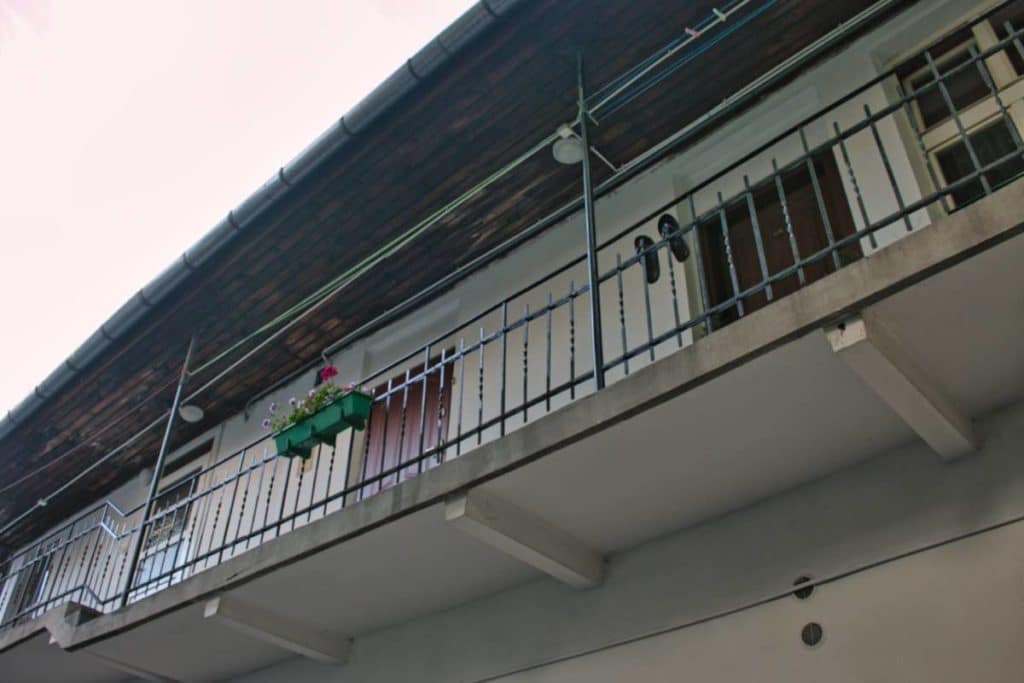
Much of this is also due to the notoriety of the story of Krakow’s Jews in the Holocaust the portrayal in the film Schindler’s List. Since then, a real boom has begun, through which many visitors come to Kazimierz to see Jewish Krakow.
The most interesting places in Kazimierz Krakow
Kazimierz has managed to preserve its very own character to this day and has quite a number of sights connected with the Jewish history of this neighborhood. These are the most beautiful of them:
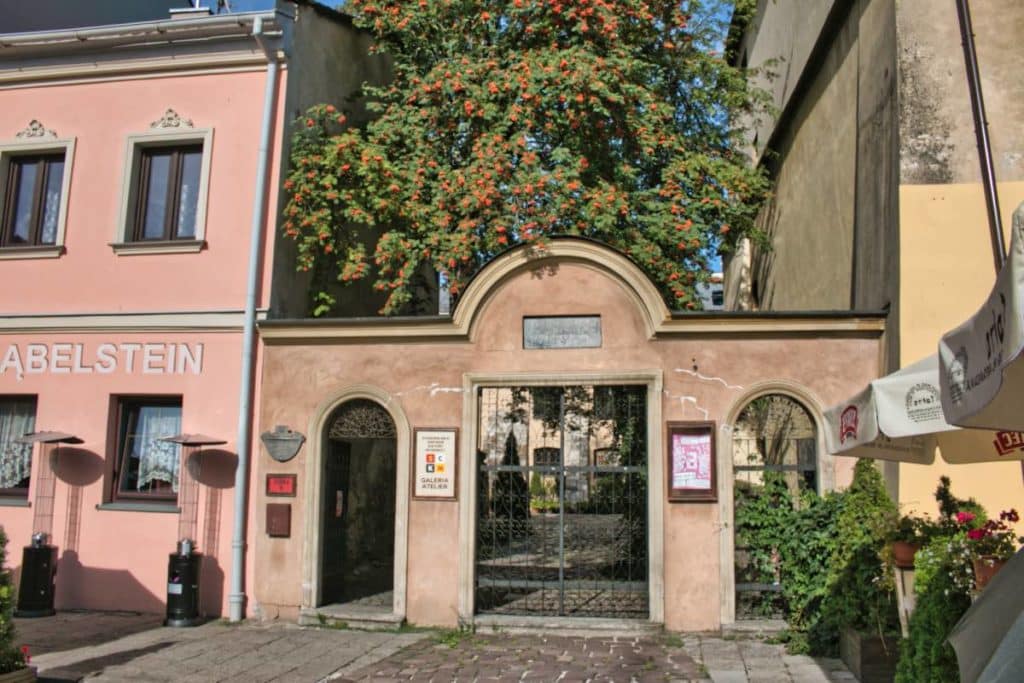
Ulica Szeroka
The Ulica Szeroka (“Broad Street”) was the center of the Jewish quarter from the 15th century and is still the main attraction in the quarter. Here you can find one café next to the other and you have the chance to taste delicious Jewish-Polish dishes, sit comfortably on one of the terraces and let the scenery with its many historic buildings work its magic on you. The southern end of the Broad Street is formed by the Old Synagogue, while the Remuh Synagogue rises at the northwestern end and the Popper Synagogue forms the eastern end. At the northern end of the Ulica Szeroka, which is more like a marketplace, there is also a Holocaust memorial.

Remuh Synagogue
In the 16th century, a wealthy citizen of Kazimierz had the idea of transforming his wooden residence into a synagogue, where his son would then teach. It burned down a short time later and was replaced by an elongated new Renaissance building. The synagogue is one of the few places, where services are still held today and served as a place of worship for the Orthodox community. The magnificent ceiling paintings inside are a real eye-catcher. Although the synagogue was looted by the Nazis, it was not destroyed afterwards, but used as a warehouse, which is why it miraculously survived the war and was restored in the 50s and 60s.
Remuh Cemetery
Directly behind the synagogue lies the most important burial place of the Jewish community of the time until 1800. Rabbi Moses Isserles, the son of the initiator of the synagogue and the synagogue’s namesake (Remuh is an acronym of Rabbi Moses Isserles), also found his final resting place here. He published the Shulchan Aruch collection of laws, which is of high importance to Ashkenazi Jews. No wonder, then, that his grave is still visited by believers from all over the world.
Popper Synagogue
The Baroque Popper Synagogue is often called the Little Synagogue and owes its name to the Jewish merchant Wolf Popper, who financed its construction. It used to be the synagogue in Kazimierz with the most magnificent interior. Unfortunately, it too was irretrievably lost due to the destructive frenzy of the German occupiers. Due to its great importance for the Jewish community, it was rebuilt after it was further damaged by a bomb attack towards the end of the war. Today it serves as a cultural center.

Old Synagogue
The Old Synagogue dates back to a Gothic synagogue that fell victim to the great fire of 1557. This had been commissioned by Jews from Prague who had fled from a pogrom to Krakow Kazimierz. It is the oldest synagogue still in existence and was built in 1550. The Italian builder Mateo Gucci transformed the old structure into a Renaissance building. This used to be the border of Kazimierz, which is why the synagogue was unceremoniously integrated into the city’s fortifications. Parts of the old city wall have been preserved, as you can see in the photo on the left. The mustard-colored building in front of it used to serve as a place of prayer for the female members of the community. Today it houses the Jewish section of the Krakow City Historical Museum.
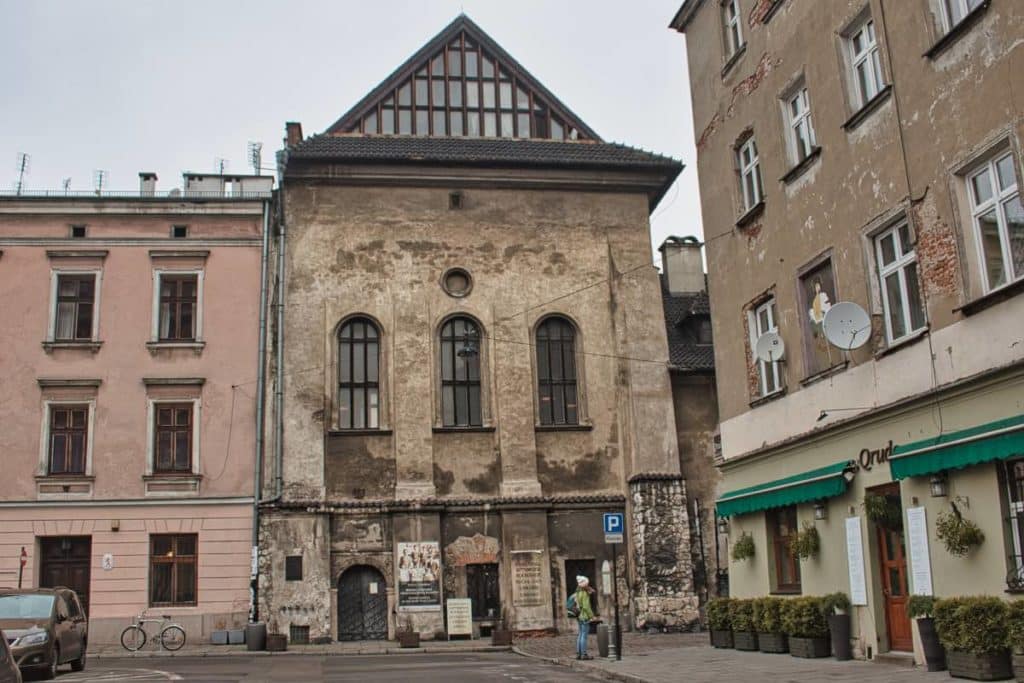
High Synagogue
The High Synagogue was also built in the Renaissance style. It owes its name to the unusual fact that the men’s prayer room is located on the top floor of the building. Unfortunately, it was heavily destroyed by the Germans. The buttresses on the south side are a typical feature of the Cracow Renaissance and are also found on many buildings in the center. An annex was built for the women of the congregation in the 17th century, which was joined by another annex in the 19th century, which with its pink facade does not really want to fit in with the overall image of the synagogue. In the 60’s and 70’s attempts were made to restore the building, but today it is unfortunately not in a good condition.
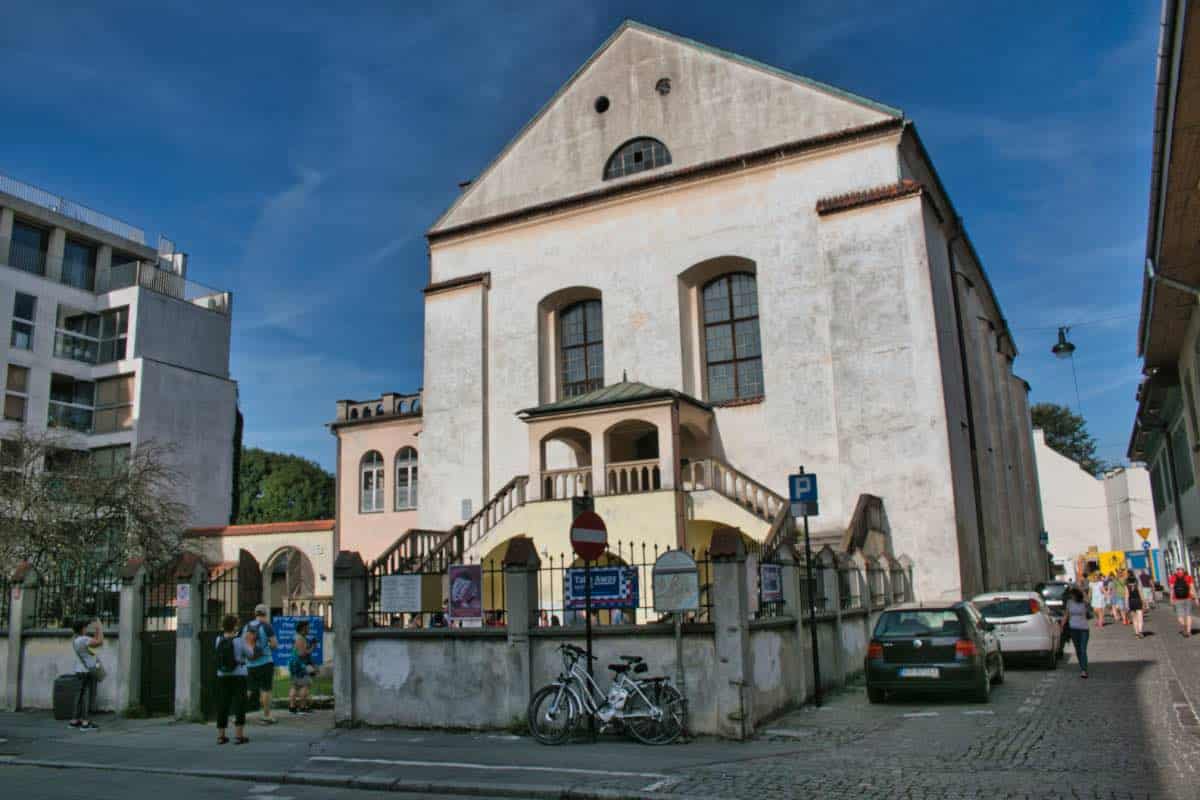
Izaak Synagogue
In the middle of the 17th century, Izaak Jakubowicz had a baroque house of worship built in the Kupa street, with an undecorated facade, which is nevertheless architecturally attractive due to its side staircases. The simple exterior belies the fact that the Izaak Synagogue used to be one of the most richly furnished synagogues in Poland.
After parts of this interior were already lost in the course of the Swedish Flood, the Germans destroyed further parts of the interior during the war. Before that, they wanted to force Rabbi Maximilian Redlich to publicly burn the congregation’s Torah scrolls. When he refused, they shot him.
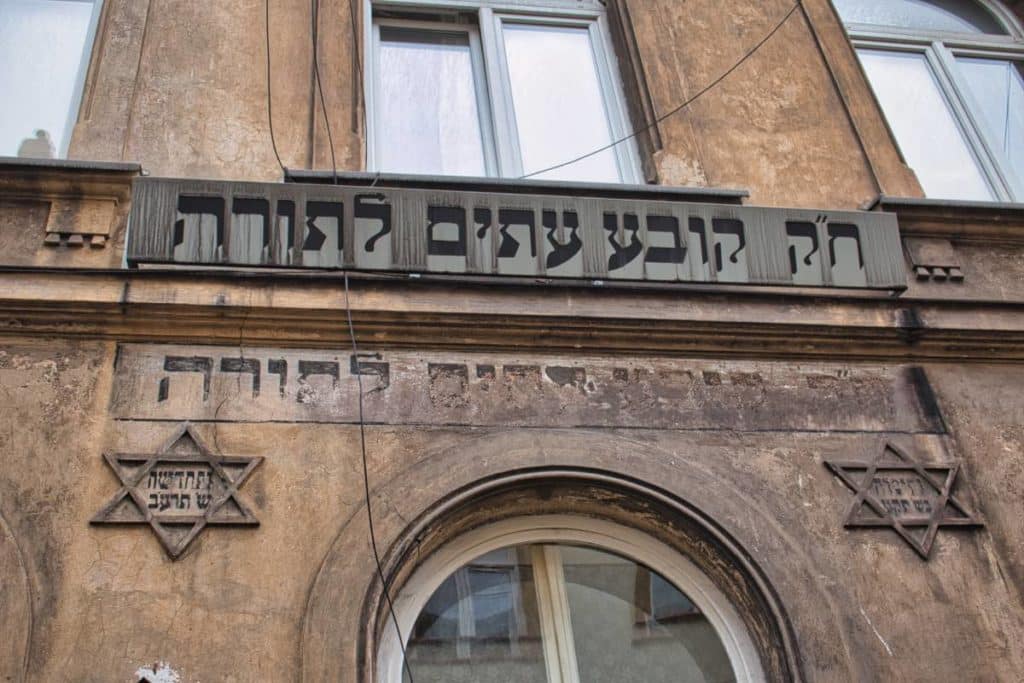
Kowea Itim le-Torah Synagogue in Krakow
The Kowea Itim le-Torah Synagogue in Krakow was also once a house of prayer for the Jews in Kazimierz. It has remained distinctive to this day, mainly because of the two Stars of David and the Hebrew inscriptions on the wall of the building. It was built in 1810 and belonged to the Kowea Itim-le-Torah Brotherhood. It was renovated in 1912 to 1913 and destroyed by the Nazis during World War II. To this day, the synagogue has not been restored and serves as a residential building.
New Jewish Cemetery
After the Old Jewish Cemetery at the Remuh Synagogue was closed in 1800, the New Jewish Cemetery served as the central burial place of the Jewish community. It is located east of the old center of Krakow Kazimierz and occupies a considerable area of almost 5 hectares. About 10,000 Jews found their final resting place here. Unfortunately, the cemetery was desecrated by the Nazis and the gravestones were used, among other things, for construction of the road to the Plaszow concentration camp. A huge monument made of broken tombstones still commemorates this crime. Although an American organization tried to rebuild the cemetery, today it looks overgrown and many stones are crooked.

Tempel Synagogue
The last of the beautiful synagogues of Kazimierz, the Tempel Synagogue was built in the middle of the 19th century. It was built in the neo-Renaissance style and has many oriental-looking elements. The building was inspired by the Leopoldstadt Temple in Vienna, which was destroyed during the Night of Broken Glass. The richly decorated Krakow synagogue was extensively renovated in the 1990s, so that today the colorful stained glass windows once again show off the golden interior to its best advantage. The fact that the house of worship survived the war relatively unscathed is due to the fact that the Germans used it as a horse stable during the occupation.
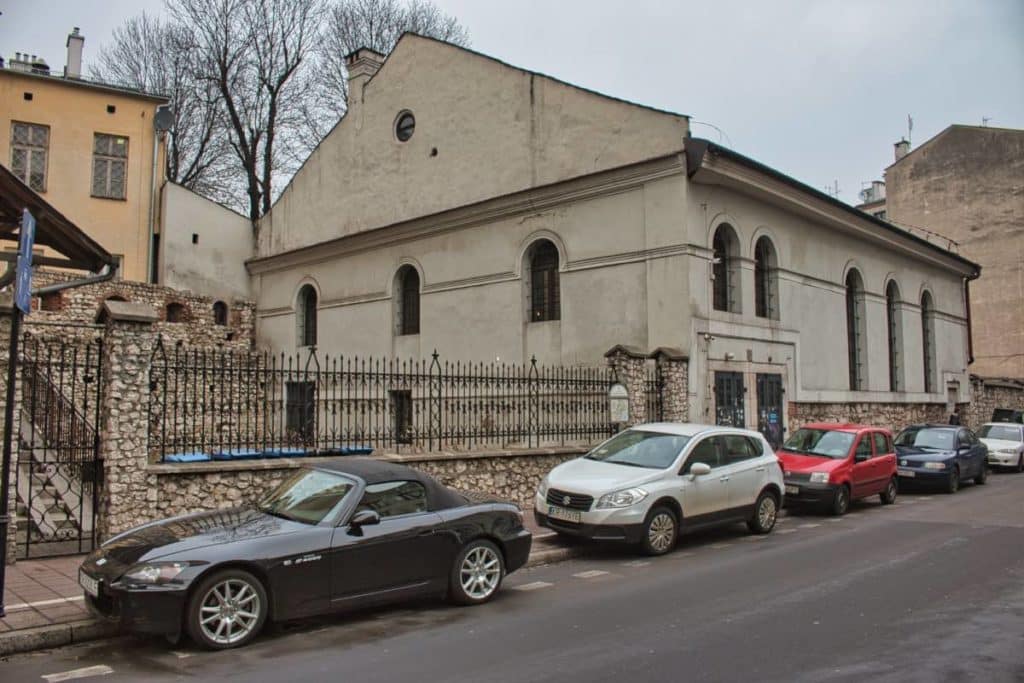
Kupa Synagogue
The Kupa Synagogue has also been preserved to this day and is still used as a synagogue. It was built in the 17th century from 1643-1648 in the Baroque style. The Kehila, the Jewish community paid for its construction. The synagogue was decorated in the 1920s with paintings of Jerusalem and Hebron, among others. On the walls also wind representations of biblical stories.
Jewish Museum of Galicia
The Jewish Museum of Galicia is the main place to go for anyone interested in the history of the region. Galicia, today divided between Poland and Ukraine, was once part of Austria-Hungary and home to millions of Jews. You can learn about their history here. At the heart of the exhibition are the photographs of Chris Schwarz, a British photographer who has succeeded in an impressive way in bringing Jewish Galicia back to life in his pictures. In addition, special exhibitions are shown from time to time, meetings with contemporary witnesses take place and guided tours through Kazimierz are organized.
Jewish places outside Kazimierz
In Krakow and the surrounding area there are many other places connected with the Jewish history of the city and testifying to the horrors of the Second World War and the Shoah. Here we present you some of them.
Schindler’s Factory
Almost everyone knows the story of Oskar Schindler, the German factory owner who saved the lives of many Jews during the war thanks to his courageous efforts, at least since Steven Spielberg’s Oscar-winning masterpiece. The enamel factory of Oskar Schindler still stands here southeast of the old town. It houses a great museum where you can learn about the Schindler and his employees, but also about the Jewish past of the neighborhood.
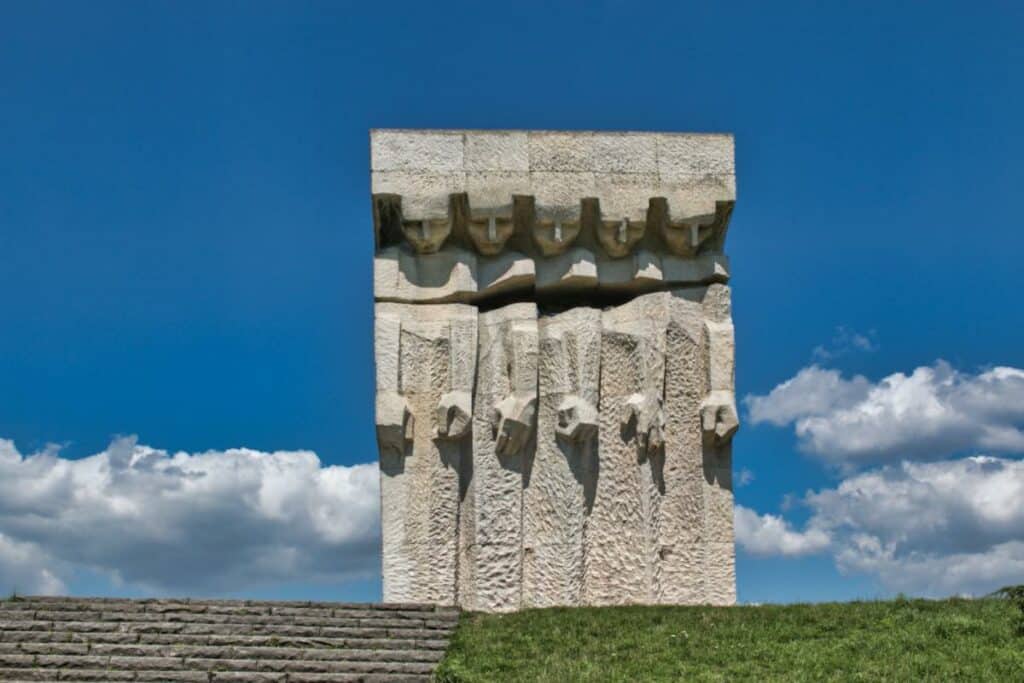
Plaszow Memorial
Unfortunately, Oskar Schindler was able to save the lives of very few people in relation to the total population. Many Jews were deported to the Plaszow concentration camp, located in a suburb southeast of the center. Here, the camp commander Amon Göth, known from the movie Schindler’s List, led a reign of terror, thousands of people died in an agonizing way. Today, a huge concrete monument showing people with lowered eyes reminds us of this place, which unfortunately is not very well maintained and is still waiting for a real memorial. Nevertheless, we think that this place needs more attention!
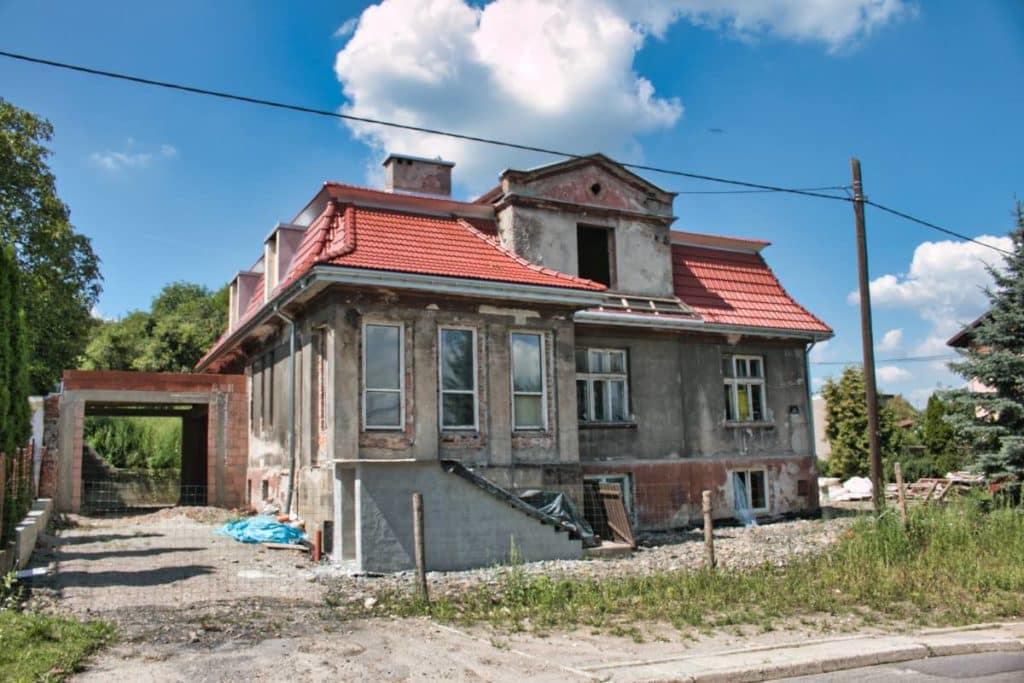
Red house – Villa of camp commander Amon Göth
One of the places in Plaszow is the so-called Red House (Ulica Heltmana 22). It was the villa of Amon Göth. Here too some incidents took place, which became world-famous through the film Schindler’s List. However, this does not include the scene in which Amon Göth shoots at the camp inmates with a rifle from the balcony of the villa. This was not possible because there was no visual contact between the villa and the camp. The street, which today is called Ulica Heltmana, was then also called SS Street, because there were also other officers’ houses here. The building was sold to a private investor. There is no evidence of the former occupant.
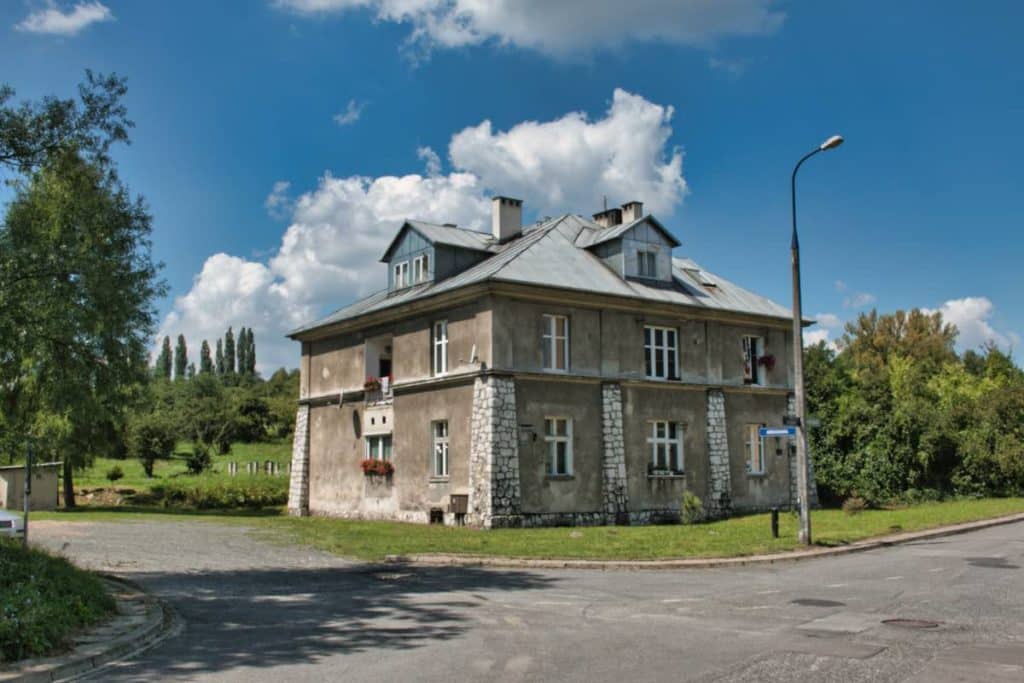
Grey House – Torture House of the SS
On the grounds of the Plaszow labor camp there was a Jewish cemetery before the German occupation. The cemetery was destroyed by the SS and the building was turned into an administrative building. This is where Amon Göth had his office. And indeed, Göth shot camp inmates from the balcony. However, unlike what is portrayed in the film Schindler’s List, he did so from his office in the Gray House. The other brutal officers also had their rooms here. The building also contained cells for solitary confinement, in which the prisoners had to stand for long periods. Only a few are said to have survived this ordeal. The house is to be turned into a museum.
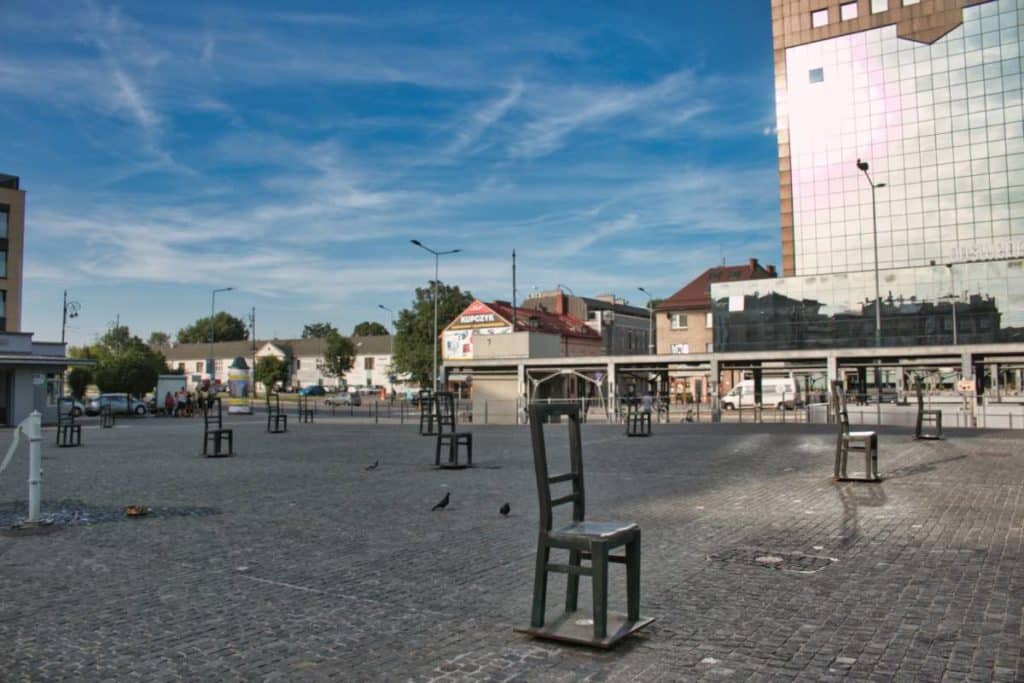
Ghetto Heroes Square
Ghetto Heroes Square is located in the middle of the former ghetto of Krakow Kazimierz. Here the inhabitants were rounded up before being deported to various concentration camps. Before the war, this was a thriving place with numerous craft stores, apartment buildings and streetcar connections. One of the most interesting objects in the square is the classicist Adler Pharmacy. It was run by Tadeusz Pankiewicz, the only non-Jewish resident of the ghetto legally living here. It developed into a place of humanity in inhumane times, where the needy and resistance fighters came together. On the square, however, the many chairs made of cast iron and bronze are most noticeable. They are empty and since 2005 they have been a reminder of the residents of the neighborhood who were never able to return here.

Liban Quarry
This place is known only by the fewest tourists who come to Krakow. Yet the Liban Quarry is one of the most beautiful quiet retreats in the Polish city. Unfortunately, it also has a sad past. The quarry was founded in 1873 by the Liban and Ehrenpreis company, which was established by two Jews. During the German occupation in World War II, the quarry was used as a forced labor camp for 800 Poles. At least 21 inmates were murdered here.
This environment was also the reason why Steven Spielberg was able to shoot the scenes of the film Schindler’s List here, which are set in the Plaszow concentration camp. The film crew recreated the labor camp here, complete with barracks and barbed wire fences. Even the main street with Jewish gravestones was recreated – don’t worry, they are only replicas. On the site there are also the remains of a small industrial plant from Poland’s communist years. Today, however, the quarry site is mostly overgrown. There are ponds and many species of animals use the quarry as a small nature reserve in the middle of Krakow. It is worth a visit, but please be careful, because barbed wire, broken glass and other debris are everywhere.
Practical tips Krakow Kazimierz
Food and Drink
Are you hungry and want to enjoy the classics of Jewish-Polish cuisine? No problem, in Kazimierz you have the opportunity!
- Ariel, ul. Szeroka 17 (Broad Street). Hummus, Sephardic-style carp, kofta lamb medallions and many other classics of Jewish cuisine are served here in a beautiful ambience.
- Dawno temu na Kazimierzu, ul. Szeroka 1 (Broad Street). “Once upon a time in Kazimierz” is the translation of the restaurant’s name. From the outside, you could easily mistake the restaurant for an old Jewish craft store, at least that’s how the signs look. Inside, there are delicious Polish and Jewish dishes, and klezmer concerts are sometimes held here.
Overnight stay
- Hotel Rubinstein*. Chic boutique hotel in the heart of Kazimierz that owes its name to Helena Rubinstein, the legendary cosmetics entrepreneur who once lived in the handsome 15th-century building.
- Klezmer Hois. Cute little hotel in the building of an old Jewish bathhouse with an attached restaurant serving classics of Jewish Galician cuisine.
Tours
On this tour* you can be guided through Kazimierz and learn a lot about the history of this special place. And if you click here*, you can book a tour that will take you to the places associated with Oskar Schindler and the Holocaust. The tour also takes you to the former Plaszow concentration camp.
Book Tips Jewish Quarter Krakow
Classical tour guide that also describes Kazimierz and the Jewish quarter in Krakow
What happened to Kazimierz after the war? This book takes a closer look at how the quarter is being regenerated.
- Murzyn, Monika A. (Author)
Great overwiev about Jewish life in Poland, that exceeds Kazimierz and also shows what life in rural places was like.
- Der Junge im gestreiften Pyjama: Eine Fabel
- Produkttyp: ABIS_BOOK
- Marke: David Fickling Books
This book focuses mainly on the small Shtetls, the litte Jewish communities in Poland, Ukraine and Belarus before the Second World War.
- Padowitz, Joel (Author)
Moving description of the Holocaust in Galicia, written by an eye witness.
- Petrovsky-Shtern, Yohanan (Author)
International bestseller about a friendship beetween two kids during the Shoah.
We can also highly recommend the Virtual Shtetl. A few years ago, I also participated in the project, which is dedicated to the preservation of Jewish heritage in Poland and, among other things, lists numerous places of Jewish history.


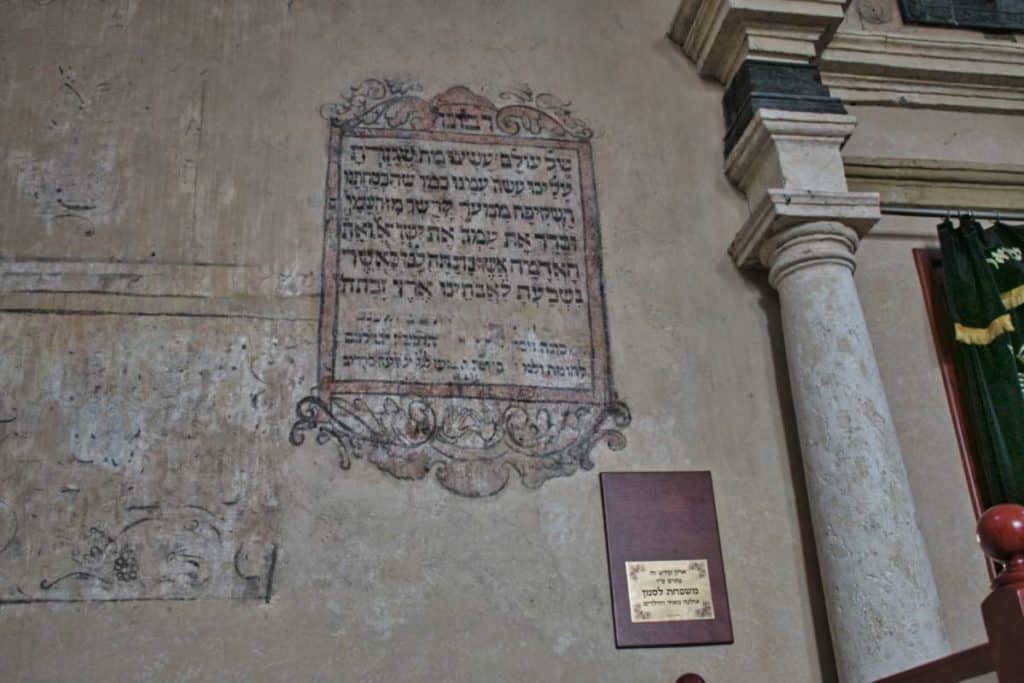

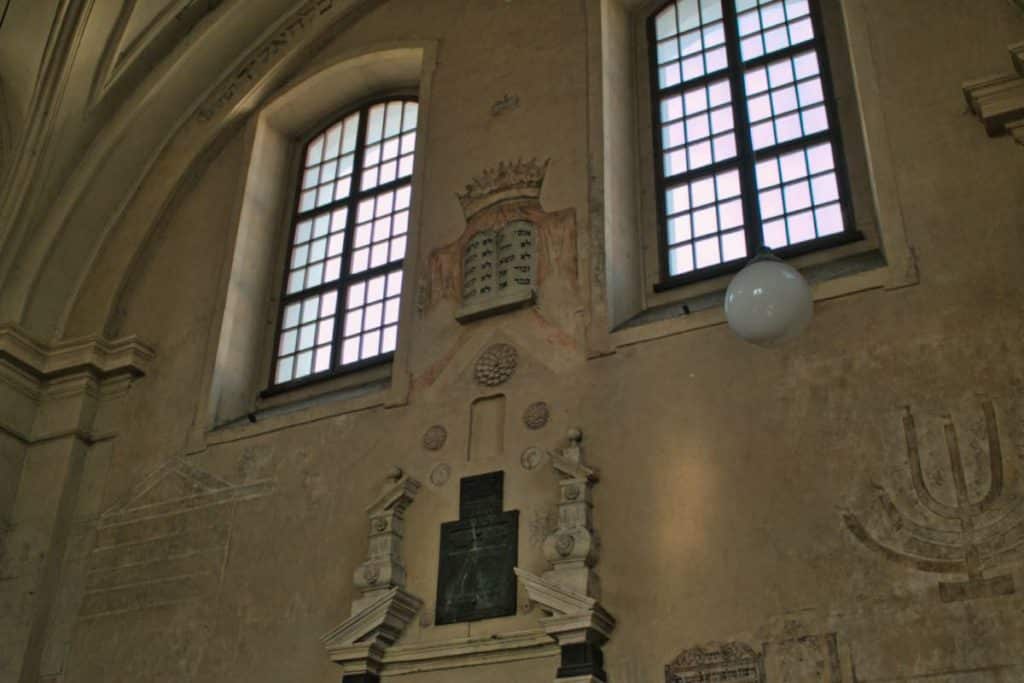







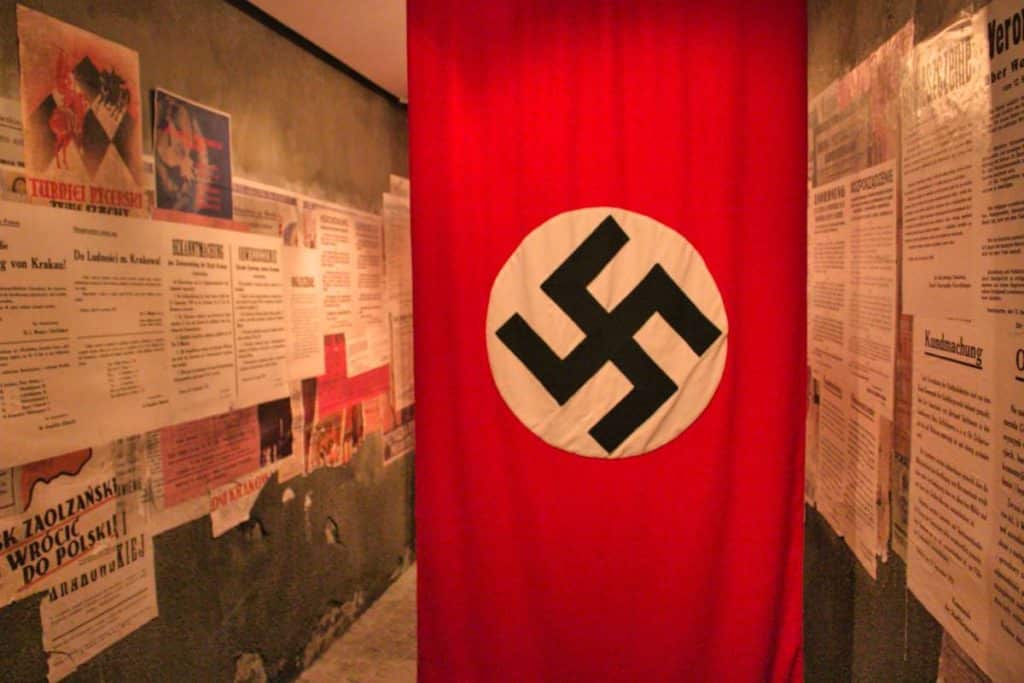

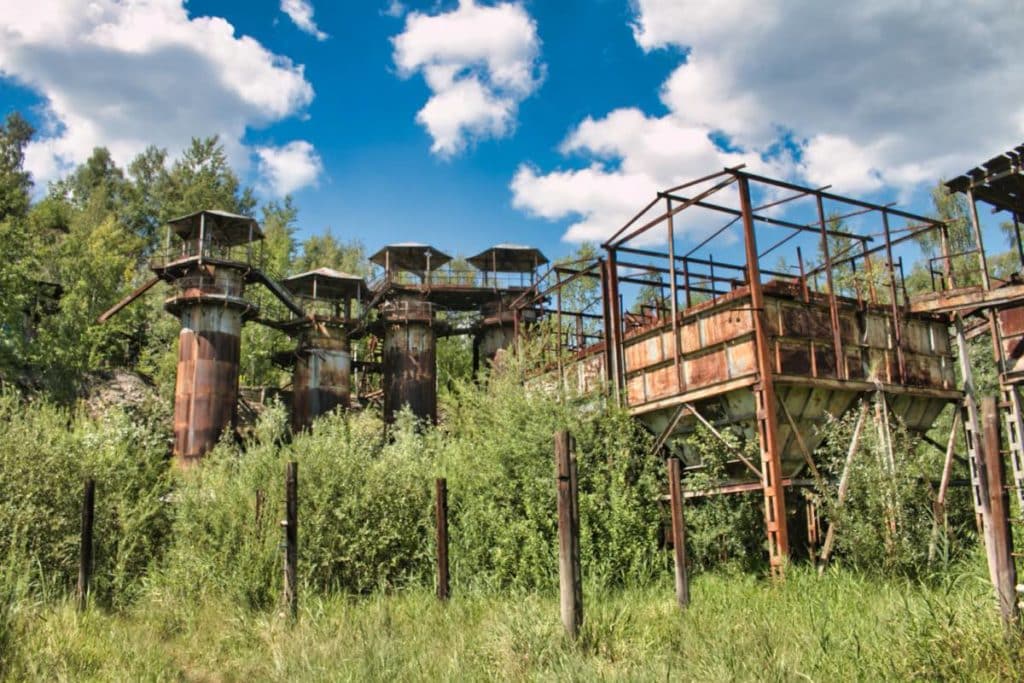





TheRe was not a Rabbi named Maximillian Redlich. That is not the correct fact. Max was a man, a regular man unreligious Jewish man, that would not spit on the Torah. Please do not perpetuate falsehoods about the Holocaust.
The barber wire around the Libyan Quarry are left over from the filming of Schindler’s list.